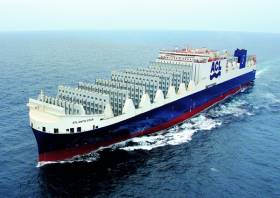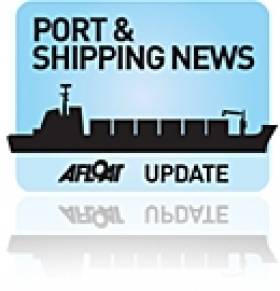Displaying items by tag: Global trade
Top 25 World Container Liner Operators
#Top25boxCo - According to Multimodal, the 14th edition of Dynamar annual Top 25 Container Liner Operators publication has been issued. It offers an exclusive insight into the world’s largest container shipping companies, their history, nature, characters, developments, strategies, relationships and performances.
The report opens with a summary of the Top 25 carriers looking at their operated vessel fleet, capacity, carryings, container box fleets and subsidiaries. Furthermore, this section includes financial results for full year 2015 and the first 9 months of 2016. A rundown of performance and financial parameters for the period 2011/2015 for operators consistently forming the Top 20 is also provided. It concludes with the shares of operated vessel capacity by region of control and by company type.
Dynamar’s latest study offers a most comprehensive overview of the financial results of the globe’s 25 largest operators. For the first time, as a group, they collectively posted a net loss in 2015, this running into hundreds of millions of dollars. Even more monetary horror is to come: for the first 9 months of 2016, the combined net result of twelve reporting lines fell by more than USD 13 billion...!
Little wonder: over the same 9-month period, spot rates quoted for the 10,500 nautical miles Shanghai-Rotterdam leg were USD 618 all-in per TEU on average. This equals less than 6 dollar cents per nautical mile. Quotations ranged between a nadir of USD 205(!) in March, and a zenith of USD 699 in July… which carrier could survive on that?
In January 2015, four East-West Alliances kicked off:
2M - Maersk Line, MSC
CKYHE Alliance - Coscon, Evergreen, Hanjin, “K” Line, Yang Ming
G6 Alliance - APL, Hapag-Lloyd, Hyundai, MOL, NYK, OOCL
Ocean Three - China Shipping, CMA CGM, UASC
Less than one-and-a-half year later, in April/May 2016 already, the relevant carriers announced drastic re-arrangements of their groupings. Taking effect April 2017, these will read:
2M+ - Maersk Line and MSC, plus Hyundai sharing space
Ocean Alliance - CMA CGM/APL, Coscon, Evergreen, OOCL
THE Alliance - Hapag-Lloyd/UASC, Hanjin, “K” Line, MOL, NYK, Yang Ming
All being well and with the permission of the FMC already in their pockets, these three new Alliances will start operations effective 1 April 2017.
It is unprecedented developments outside of the existing alliances having pushed aforementioned changes. All actualised or initiated within the space of a single year (2016), which saw six of the original Top 20 lines go, it concerns:
China Shipping merged into Coscon (February)
Acquisition of APL by CMA CGM (June)
Hanjin’s sad going under (September)
Merger-to-be of UASC into Hapag-Lloyd (1Q2017)
The proposed joint venture between “K” Line, MOL and NYK (September 2017)
Maersk Line’s intended acquisition of Hamburg Süd (late 2017)
In the course of all the above sweeping, powerful changes, smaller liner companies come under great pressure to consider consolidation as well: 2017 promises to become another exciting year!
Concluding the “Top 25 Container Liner Operators (2016)” study is a separate chapter on Alliances, Consortia or similar. Profiles are provided on each of the present and future groupings.
Cost reduction, in the form of larger, less gas guzzling and more efficient ships has been the answer to low rates of the top container liner operators. It started with Maersk Line’s 2006-launched 15,600 TEU E-class, developed and built for the Europe-Far East trade. High volumes; an excellent relationship between time spent at sea versus time in port; capable container terminals: this trade is the ideal route for ULCS to reap the maximum from their economies of scale.
Worried by the Danish company’s lower slot costs eroding their market share, other carriers followed suit in big numbers. By mid-2016, eighteen of the Top 25 lines controlled 100% of all ULCS operating and 94% of the orderbook, representing 366 ships/4.9 million TEU, and 156 vessels/2.7 million TEU, respectively. Capacities range between 10,000 TEU and 21,200 TEU. By the end of 2016, 178 ULCS with an average capacity of 15,300 TEU operated between North Europe and Asia.
A deluge of large newbuildings combined with a faltering market resulting in severe overcapacity inducing a bitter rate war ensuing dramatic losses: it is the price of too many too big ships...
Aware of the overcapacity damage done with their financials turning deep dark red, no carrier ordered any ULCS in 2016. That is to say, almost, as in December IRISL fulfilled an earlier “promise” to go for ULCS as well, ordering an initial 14,500 TEU units.
Cold comfort, but it is not container liner shipping alone immersed in uncertainty. Breakbulk, heavy lift, dry bulk, tankers, non-operating owners, you name it, all main shipping segments are concurrently groaning under a downturn as severe as seldom seen before. It can barely get worse.
In addition to maturation, container shipping also faces the yet largely unknown effects on cargo streams of 3D-printing and robotising facilitating near shoring.
Interestingly, despite all doom and groom, at the very end of 2016 it was reported that shipping industry confidence had hit its highest level in 15 months. That’s the spirit, that typifies shipping!
It may have helped that in the fourth quarter, spot rates in all long haul trades from Shanghai saw a recovery, to positively influence the level of contract rates for the new year. Scrapping has never been as high as 700,000 TEU. Troubles are not, but would the worst be over!?
Ongoing container liner consolidation as so convincingly initiated in 2016 should help addressing all challenges if... the larger companies and Alliances seriously work on eradicating the current excess tonnage while keeping future capacity expansion in check.
And finally: 2006 ended with (ultimately) eight companies less than it started with. No worry, as long as there is worldwide water and trade, there will be 25 largest container liner companies with all of them worth to know everything about them!
Many more topics and subjects than the above are discussed and analysed in the core of the 2016-edition of Dynamar’s “Top 25 Container Liner Operators” which consists of the profiles of each of the individual Top 25 carriers and their affiliated companies. In summary, each profile contains:
An opening page of at-a-glance key details, overviews, indexes and ratios on literally anything container shipping company-relevant, showing the subject’s progression since 2005
A history and corporate background section: how the carrier got to where it is today
Operated containership fleet and orderbook development
Trade lanes and markets served as a vessel operator and as a slot-charterer
Overview of interests in container terminals worldwide
Summary of container-related and other relevant affiliations or activities
Membership of alliances, consortia, conferences and discussion agreements
Concluding the study is a glossary featuring all major, main and regional trade lanes along which the Top 25 are active (as vessel providers) listed by trade and country. All this is complemented by around 145 different tables and another 50 figures of supporting information.
The 2016 edition of the Top 25 Container Liner Operators is immediately available and can be ordered for direct download under the link www.dynamar.com/publications/173
#PORTS & SHIPPING – Today is the International Day of the Seafarer, and people around the world are being asked to use social networks to highlight just how important seafarers are as they transport more than 90% of global trade which are vital to our daily lives.
On this second year of the Day of the Seafarer, people are asked to tell the world of an object in their daily life that you can't live without, and which came by sea.
Take a photo of the object, write a description, record a song, make a film, whatever you prefer: and then just post it on the social platform of your choice and add the campaign slogan: "thank you seafarers".
Seafarers leave their homes and families, often for long periods to ensure that essential items and commodities on which our lives depend arrive safely at our homes.
So show the seafarers of the world - and your friends, too – your appreciation of the extraordinary services they render every day of their professional lives, under demanding and sometimes dangerous circumstances.
Day of the Seafarer is an innovative campaign that harnesses the power of social media to raise awareness of seafarers and their unique role. Everyone, regardless of where they live, can join the campaign online. So, on 25 June, you can join in by:
Sharing your post on Facebook, if you have pictures, videos or any special message, please share them on our wall.
Sending us a message @IMOHQ and @SeafarerDay using hashtag #thankyouseafarer
On pinterest, you can pin a picture of your chosen object with the caption "Day of the Seafarer"
For more infomation and for how participants can download the toolkits available of the campaign click HERE. In addition for a video message by Koji Sekimizu, Secretary-General of the International Maritime Organization (IMO).
The IMO is the United Nations specialized agency with responsibility for the safety and security of shipping and the prevention of marine pollution by ships. The organisation is headquartered in London on the banks of the Thames.































































